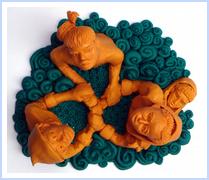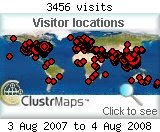By Ma. Cecilia Rodriguez, Nash Maulana
Mindanao Bureau
Last updated 05:50pm (Mla time) 08/24/2007
CAGAYAN DE ORO CITY, Philippines -- A tribal group based in Bukidnon has expressed dismay over the alleged failure of the National Statistics Office to accurately count them in this year's population census.
"How can they count us properly when they don't go to our areas? They only go to the sitio (sub-village) proper," said Bai Carmen Tigbabao Lopez in the vernacular.
Lopez is an official of the Maramag-Manobo Tribal Association of San Miguel in Bukidnon.
Earlier, Muslim leaders in the Autonomous Region in Muslim Mindanao also made the same observation.
Physician Tahir Sulaik, ARMM health secretary, said by national and regional health department figures, the Muslim population grew at the rate of 3.2 percent in the last four years, faster than the national growth rate of 2.7 percent.
But the ARMM population has remained unchanged at 2,744,987 in the 1997 and 2000 population and poverty incidence figures of the United Nations Development Program's most recent edition of Philippine Human Development Report (PHDR).
Muslim scholar Datu Michael Mastura said Philippine Muslim population, often reported at three million, has hardly changed since the first census was conducted in 1903, when Muslim-Christian population ratio then was placed at 2:1 in Mindanao.
Like Lopez, Mastura said enumerators only concentrate their work in town centers.
Tommie Labaon, director of the National Commission on the Indigenous People (NCIP) for Northern Mindanao, echoed Lopez's observation.
"For this year's census, we will not be counted (properly)," said Labaon, a Higaonon.
Labaon said getting an accurate count of the indigenous peoples in the country has been a perennial problem.
"In 2002, there was a move by the NCIP central office with the NSO that there should be a separate counting or there should be another questionnaire so that the lumads or indigenous peoples nationwide would be counted. But it was very expensive and the NCIP could not afford it. So as talks went on for this August census, the IPs cannot still be counted," he said.
Labaon said the NSO only promised to count as many members of the indigenous communities and also pledged to hire enumerators that are from the tribal groups.
But that would be in 2010 yet.
"[NCIP secretary] Grace Pascua initiated a series of consultations with the NSO to formulate a separate system to count the lumads. [NSO secretary] Africa said that they will do that in 2010," explained Labaon.
As for Lopez, she said she made sure that all members of her clan will be counted.
"It was easy for us to be counted because we live near town. For those who lived farther in the mountains, I don't think they were counted," she said.
Labaon estimated that only 25% of the members of the indigenous communities in the region have been properly accounted for.
He said that based on a 1986 study, Region 10 has the second largest IP population in Mindanao at more than a million.
"But this was also based on estimates, no accurate counting was ever done," Labaon said.
"There are big lumad barangays in Region 10. Most have eight to 10 sitios. What the enumerators usually do is to stay in the sitio proper and merely ask the barangay officials for an estimate of the population living in the other sitios. That means the rest of the people are not included in the census" he said.
Labaon said the census also appears to be very dependent on public transportation.
"There are places where public transportation is only available until 1:00 p.m. so what the enumerators do is to rush up their interview so they can catch the last trip," he said.
Another reason, he said, could be the fact that communist rebels operate in many lumad areas.
"Around 97% of our ancestral domains are NPA-infested," he said, noting that census takers do not go there for fear of their lives.
Luis Alquiza, NSO regional information officer, confirmed that it was very difficult for them to take a census in areas where NPA’s are known to operate.
"In extreme cases where the area has an ongoing 'rido' (clan feuds) or tribal conflict, we consult with the imams (religious leaders) or the Council of Elders," he said.
As early as June this year, NSO has begun recruiting and training enumerators for the census.
Arquiza said all enumerators were properly trained on how to interview IPs and Muslims.
"They all go through intensive training. We teach them techniques on how to ask the questions indicated in the questionnaire," he said.
Arquiza admitted, however, that language barrier could be a problem. "If the enumerator does not speak their language, they shy away," he said of the lumads' attitude. "We are fortunate here in the region because most of the IPs are already more 'civilized'."
Labaon also noted that the NSO questionnaire did not reflect the tribal origin or the ethno-linguistic groupings of a respondent.
"So whether a Bisaya, an Ilonggo or a tribal member, the set of questions is the same. Most likely if the conduct of the interview is in the Cebuano dialect, all the [respondents] are Cebuano," he said.
Bagong Simula sa Bayan ni Juan
Breaking News
For other news and information, scroll the links found on the sidebar. Links to other relevant sites and media blogs are located on the lower right portion. - RAFS76
Saturday, August 25, 2007
Ethnic groups fear not being counted properly in census
Posted by PhilMADE at 3:49 PM
Subscribe to:
Post Comments (Atom)













0 comments:
Post a Comment